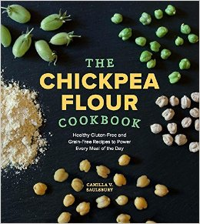
Are chickpeas the new hot food and chickpea flour the easiest way to go gluten-free?
What are the signs?
Recently, Joe Yonan wrote about chickpea pancakes called farinata in The Washington Post.
Perhaps the beginnings of a thaw of relations between Iran and Washington mean that Americans will get into the habit of tucking into melt in your mout nan-e nokhodchi (chickpea flour cookies).
 Finally, Camilla V. Saulsbury’s The Chickpea Flour Cookbook (Lake Isle Press 2015) is full of traditional and new ways to use chickpea flour in every meal. On the cover is a photograph of dried chickpeas, flour, pods, and fresh peas. If you are luck, you’ll find them all at a local market. The flour is relatively easy to find, often labeled besam flour. With it you can make a full day of chickpea flour dishes. Breakfast? Start with Cottage Cheese Pancakes with Blueberry Chia Jam (p. 41) that are close to light blintzes. They cook up crisp on the outside and tender on the inside. The chickpea flour does not give them a “bean-y” taste. You could also make Ginger Scones with Chickpea Lemon Curd (pp. 53-54) with chickpea flour in both the pastry and the curd.
Finally, Camilla V. Saulsbury’s The Chickpea Flour Cookbook (Lake Isle Press 2015) is full of traditional and new ways to use chickpea flour in every meal. On the cover is a photograph of dried chickpeas, flour, pods, and fresh peas. If you are luck, you’ll find them all at a local market. The flour is relatively easy to find, often labeled besam flour. With it you can make a full day of chickpea flour dishes. Breakfast? Start with Cottage Cheese Pancakes with Blueberry Chia Jam (p. 41) that are close to light blintzes. They cook up crisp on the outside and tender on the inside. The chickpea flour does not give them a “bean-y” taste. You could also make Ginger Scones with Chickpea Lemon Curd (pp. 53-54) with chickpea flour in both the pastry and the curd.
Hungry for pumpkin? She includes Pumpkin Spice Waffles (p. 42), Spiced Pumpkin Bread (pp. 82-3) topped with pumpkin seeds, and Pumpkin-Sage Gnocchi (p. 143) all made with chickpea flour. Among the more traditional uses are in Farinata (p. 60) and Pudla (p. 75) a kind of spicy Indian crepe, as well as Panisses (Chickpea French Fries) (p.p. 106-7) from Marseille. Super Chef also liked the Za’atar Chickpea Crackers (pp. 94-5), our other favorite “in” food.
Chickpea flour isn’t just for the gluten-sensitive. It’s a high protein, nutritious flour that adds nutty flavor to many recipes. Camilla has plenty of fun recipes to explore. So, add chickpea flour to your repertoire of falafel and humus!
